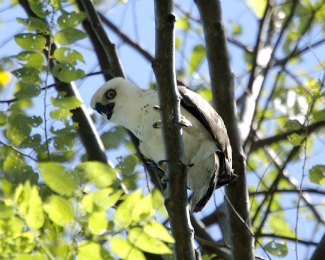Sulawesi Hawk Eagle - Nisaetus lanceolatus
By Lip Kee, CC-BY-SA-2.0, via Wikimedia Commons/ Flickr
Family: Accipitridae
Genus: Nisaetus
Species: N. lanceolatus
Sulawesi Hawk Eagles are small- to medium-sized eagles endemic to Sulawesi and surrounding islands. They form a clade with Nisaetus cirrhatus (Crested Hawk Eagle), N. philippensis (Philippine Hawk Eagle), and N. pinskeri (Pinsker’s Hawk Eagle). They are also a sister species to N. cirrhatus.
Physical Description:
Sulawesi Hawk Eagles are black-brown from above with rufous markings on the cheeks and collar. The tail is gray to brown-gray with three or four black bars, and the throat, belly, thighs, and legs are white with dark barring. There are black malar stripes along the head and the breast is rufous. The tail coverts are tipped with white and the primary feathers have white bases and faint gray barring.
Juveniles are dark brown from above with a gray-brown tail that has 5-6 black bars. The head is white and there are brown streaks along the crown, nape, and breast. The eyes are brown to light yellow, the cere is dark gray, and the feet are yellow.
Their call is a sharp, repeating whistle. Listen to a Sulawesi Hawk Eagle.
Size:
Length: 55-64 cm
Wingspan: 110-135 cm
Habitat and Distribution:
They live in primary and secondary forest in mountains and lowlands. They are found from 0-2,000 meters above sea level, though most often between 250-1,500 m.
Sulawesi Hawk Eagles are, as their name would indicate, endemic to Sulawesi and surrounding islands, including Bangka, Lembeh, Muna, Buton, Pelen, Taliabu, and Mangole in the Sula island group, from 2°N to 6°S. They are probably sedentary. There are an estimated 1,000-10,000 individuals.
By Lip Kee, CC-BY-SA-2.0, via Flickr
Diet and Hunting:
Their diet is most likely birds, mammals, and reptiles, and chickens have been recorded. Little is known about their hunting methods, but they probably still-hunt from a perch.
Reproduction:
The breeding season is from May-August. Only one nest has ever been described, and it was 20 m high in a tree. Incubation and nesting periods are unknown.
Conservation:
Sulawesi Hawk Eagles are considered common throughout their range, but are threatened by habitat loss and persecution, the latter because they eat chickens and domestic pets. They are currently listed as Least Concern by BirdLife International.
Taxonomy:
N. lanceolatus was found to be a sister species to N. cirrhatus (Crested Hawk Eagle) based on sequencing of one nuclear and two mitochondrial genes, and forms a clade with N. cirrhatus, N. philippensis (Philippine Hawk Eagle), and N. pinskeri (Pinsker’s Hawk Eagle).
Nisaetus lanceolatus was formerly placed in the genus Spizaetus, as were all other Nisaetus species, but molecular studies have shown that Asian hawk eagles are part of a different line than New World hawk eagles (Spizaetus). Therefore, all were moved from Spizaetus to the new genus Nisaetus.
Other Names:
Celebes Hawk Eagle, Orel celebeský (Czech), Sulawesihøgeørn (Danish), Celebeskuifarend (Dutch), Sulawesi tuttkotkas (Estonian), Celebesinjalokotka (Finnish), Aigle des Célèbes (French), Celebesadler (German), Boankwéa, Elang Sulawesi jambul (Indonesian), Spizaeto di Sulawesi (Italian), Serebesukumataka (Japanese), Sulawesiskogørn (Norwegian), Wojownik krótkoczuby (Polish), Aguila-azor de Célebes (Spanish), Sulawesiörn (Swedish).
Video of a Sulawesi Hawk Eagle:
References:
http://avibase.bsc-eoc.org/species.jsp?avibaseid=4A033B09014C424B
BirdLife International (2012) Species factsheet:Nisaetus lanceolatus. Downloaded from http://www.birdlife.org on 06/04/2012.
Global Raptor Information Network. 2012. Species account: Sulawesi Hawk-eagle Nisaetus lanceolatus. Downloaded from
http://www.globalraptors.org on 6 Apr. 2012
BirdLife International 2009. Nisaetus lanceolatus. In: IUCN 2011. IUCN Red List of Threatened Species. Version 2011.2.
www.iucnredlist.org. Downloaded on 06 April 2012.
http://www.planetofbirds.com/accipitriformes-accipitridae-sulawesi-hawk-eagle-nisaetus-lanceolatus
Ferguson-Lees, James, and Christie, David A. Raptors of the World. Houghton Mifflin Company, 2001.

